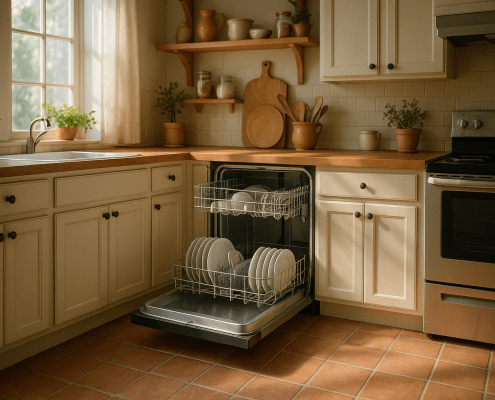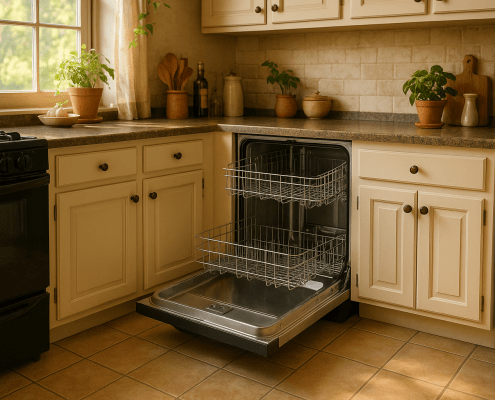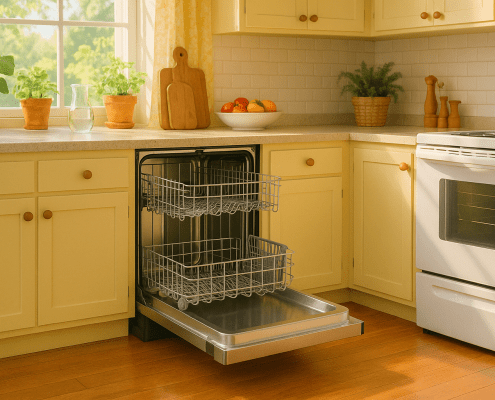How To Replace A Dishwasher Drain Hose (With Video!)
APP Expert / Monday March 21, 2022
Is your dishwasher turning your kitchen floor into a mini lake? A leaking dishwasher can be more than just an inconvenience—it can lead to bigger water damage issues. Often, the culprit is a damaged drain hose, a simple fix that you can tackle today. Scroll down to watch our step-by-step video guide and restore your dishwasher to its leak-free glory!
Need a replacement drain hose for your dishwasher? Search below using your specific dishwasher model number to identify the exact part needed:
A number of issues can lead to leaks in a dishwasher, and all of them are problems you want to fix quick, but maybe none quite as much as a damaged drain hose. If you’re seeing dirty water spills from the bottom of your dishwasher or under the sink, it’s likely the drain hose. Sharp food debris like bones can damage the hose, causing punctures or cracks along the line, and the rubber connectors on either end of the hose may degrade over time, leading to leaks at the hook-up points.
Luckily, this is a quick, cheap, and easy fix. There are some plumbing codes to keep track of, but they aren’t difficult rules to follow at all! In this tutorial, we’re walking you through how to replace a dishwasher drain hose. Don’t forget to check out the companion video for an in depth look at how each step is done.
Finding The Right Replacement Part
To track down a compatible part, you’ll need to know the model of your appliance. Need help finding the model number? If you don’t have access to the manual, the model number should be on a label sticker somewhere on the appliance. On dishwashers, check for the label inside the door. You might find it on top or side of the door itself or somewhere on the door jam.
Once you’ve got that, use the search bar to search AppliancePartsPros.com with your model number. We’ve got genuine OEM parts for every major brand, and they’ll be delivered to your door in just a few days. While you’re there, you can check out tips and advice from both our experts and other do-it-yourselfers.
How To Replace A Dishwasher Drain Hose
For this tutorial, we replaced the drain hose on a Frigidaire dishwasher. Because you’ll find the drain hose connected in the same way and the same place on most dishwashers, even if you own a different brand or model, you should be able to follow our guide to replace your appliance’s drain hose yourself. If any of the steps we’ve laid out here don’t line up exactly, you can consult your manual for diagrams listing locations of various parts, and check out our YouTube channel. We have plenty of how-to guides for a variety of appliance brands.
Keep the following things in mind when installing a new drain hose in your dishwasher:
- Aside from the high loop, make sure the new drain line has as few bends in it as possible to ensure that waste water flows out easily.
- You need a high loop and/or an air gap at the dishwasher drain. This prevents waste water – and potentially raw sewage – from backing up into your dishwasher’s basin in the event of clogged plumbing. This is a requirement of basic plumbing code in most areas in the US, and is recommended by all major appliance manufacturers. A high loop is a loop or slight U-bend in the hose that must be at least 20 inches off the floor. Often, to achieve this, the drain hose is secured to the wall of the cabinet just below the countertop with a clamp. An air gap is a device that safely prevents water from back flowing into the dishwasher. It connects the dishwasher drain to the countertop near the sink and peeks up over the top of the countertop before going down into the drain. Our video tutorial assumes you have an air gap installed in your kitchen already.
- The hose should be installed at a higher level than the dishwasher’s water level.
- Do not connect the dishwasher drain to the sewer side of the P-trap. Sewer gasses, which are dangerous to inhale, could leak into the dishwasher.
Tools for the job
A few basic tools are needed to complete this job:
- A compatible replacement drain hose
- Phillips head screwdriver
- 5/16-inch nut driver
- ⅝-inch wrench
- Appliance mat or large towel
- A clamp and mounting screw, if installing a new high loop on the line
- Extra towels
- Work gloves
Before you begin…
For safety, be sure to disconnect your dishwasher from power either at the wall outlet or circuit breaker. For this job, you should also turn off the water supply, bail any water out of the dishwasher, and empty any dishes that may still be inside. You won’t be doing much work on the interior of the dishwasher, but you will be moving the dishwasher around and opening and closing the door. Any water inside can spill out when you move the appliance, and will certainly pour out when you swap the drain hoses.
Replacing a drain hose
- Open up the dishwasher door and remove the Phillips screws across the top. To complete this job, the dishwasher will need to be pulled out of the cabinets, so we’re starting by removing the screws holding it in place. If removing your dishwasher looks a little more involved than just removing some screws, check out our guide for how to uninstall a dishwasher for more detailed steps.
- Open up the sink cabinets and disconnect the dishwasher drain line and water fill line. Water may spill out of these hoses when they’re removed, so lay down some towels first. The drain hose will need to be removed with a nut driver, while the water line can be loosened and removed with a ⅝-inch wrench. If your drain hose is clamped in place with a high loop, you’ll want to also remove that, as well.
- Remove the dishwasher from the cabinet. Here, you may want to use an appliance mat or towel – move the dishwasher onto that and slide it out of place to avoid damaging your floor. You may also need to make sure that the hoses don’t get stuck on the cabinet opening as you move the appliance.
- Follow the drain hose to the back of the washer and loosen the clamp holding it in place. The clamp holding it in place is held on by a hex head screw, use your nut driver to remove it.
- Lay a towel down. Water will probably spill out when the hose is removed.
- Work the drain hose off the dishwasher by hand, and wipe down the sides of the hook-up on the dishwasher if they’ve got gunky build up.
- Prep the new drain hose if necessary. The new drain hose will likely come with a universal fit attachment on it. Match it against your old hose, and if needed, cut it down so that it fits on your dishwasher’s drain.
- Hook the new drain hose to the pump. Work it on by hand, and then slide the clamp back into place. Finally, tighten the nut back down to secure it.
- Run the lines and power cord back through the cabinets. You may have to move your dishwasher a little closer to the cabinets to have enough slack to do this. Just leave yourself enough room to easily thread the water supply, drain line, and power cord back through the cabinet wall.
- Push the dishwasher in about halfway.
- Check under the sink and pull the lines and power cord all the way through so that they don’t get caught on anything as you push the dishwasher in the rest of the way.
- Push the dishwasher in the rest of the way and then reinstall the mounting screws across the top. Make sure that the dishwasher is pushed back far enough that the mounting brackets align with the screw holes. You may need to pull the hoses further into the sink to get the dishwasher back far enough.
- Reattach the water line and tighten it down with a ⅝-inch wrench.
- Hook the new drain line up to the air gap and tighten the clamp back down. If you don’t have an air gap installed, make sure to install the hose with a high loop by clamping a portion of it to the wall of the cabinet directly below the countertop.
- Plug the dishwasher back in, turn the water supply back on, and test things out. Don’t jump right into doing the dishes just yet! Select a dishwashing cycle, allow the basin to fill, and then cancel it and let it drain. Make sure water is draining properly, and check for leaks at the two points where the drain hose is connected.
Wrapping Up
If your dishwasher is leak free after a test run, congratulations! You’ve successfully repaired your appliance. Feeling good about that fix? Imagine what else you can do! The next time you need tips, tutorials, or genuine replacement parts, come on back to AppliancePartsPros.com in mind. Our expert-made how-tos, community advice, and quality OEM parts will make any repair job a whole lot easier.
If you need any replacement parts for your appliances, you can enter your model number at AppliancePartsPros.com to locate and order them quickly. Most orders arrive in just two business days, and we have tons of great information in our repair help section and YouTube videos to help you troubleshoot.
Stay connected with the latest DIY tips, tutorial videos, and repair guides by following us on Facebook, Instagram, and Twitter. We love hearing about your repair stories and successes. If you need more help or want personalized guidance, feel free to contact or call us at 877-477-7278. We’re ready to help you take on your next project with confidence!
Since 1999, AppliancePartsPros.com has helped millions of people repair their broken appliances by providing high-quality original parts at well below retail prices, free support and troubleshooting, and award-winning customer service from an expert, friendly, US-based customer support team!
Hi! I’m Matt H., and I’m thrilled to be your guide through the world of appliance repair with over 25 years of invaluable experience in the industry.
From the early days of my career, I have been deeply passionate about appliances and their inner workings. Over the years, I’ve seen it all – from vintage models to the latest cutting-edge technology – and I’ve dedicated myself to mastering the art of repair. With a toolbox in one hand and a wealth of knowledge in the other, I’ve tackled every challenge that has come my way, learning and growing with each repair.
Join me as we dive into the intricacies of appliance repair. From step-by-step repair guides to explanations of common problems and their solutions, I’ll be here to simplify the repair process and empower you with the knowledge you need to keep your appliances running smoothly.
Feel free to explore our blog, ask questions, and leave comments – this platform is a space for learning, sharing, and growing together. Let’s work together to ensure that your appliances continue to serve you for years to come.
Thank you for joining me on this journey, and I look forward to being your go-to resource for all things related to appliance repair!





